The Veterinary Anesthesia Machines Market is estimated to be valued at USD 968.9 million in 2025 and is projected to reach USD 1906.0 million by 2035, registering a compound annual growth rate (CAGR) of 7.0% over the forecast period.
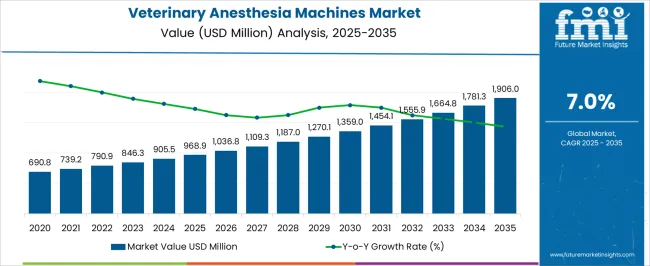
| Metric | Value |
|---|---|
| Veterinary Anesthesia Machines Market Estimated Value in (2025 E) | USD 968.9 million |
| Veterinary Anesthesia Machines Market Forecast Value in (2035 F) | USD 1906.0 million |
| Forecast CAGR (2025 to 2035) | 7.0% |
The Veterinary Anesthesia Machines market is witnessing robust growth, driven by the rising demand for advanced veterinary care and surgical procedures for animals of all sizes. Increasing adoption of modern anesthesia systems is being supported by the growing emphasis on animal welfare, clinical efficiency, and safety during surgical interventions. Technological advancements, including precise gas delivery, automated monitoring, and integrated safety features, are enhancing operational performance and reducing procedural risks.
The market is further shaped by the expansion of veterinary hospitals, specialty clinics, and research centers that require reliable anesthesia equipment for both routine and complex procedures. Rising awareness of the importance of veterinary healthcare and regulatory guidelines promoting standardized anesthesia practices are fueling adoption across various animal types.
Continuous innovation in machine portability, compact designs, and software-assisted monitoring is providing flexibility for diverse clinical settings As the veterinary care sector continues to expand globally, the market is expected to grow steadily, supported by increasing investments in healthcare infrastructure, the adoption of sophisticated anesthesia technologies, and the rising prevalence of pet ownership and animal research initiatives.
The veterinary anesthesia machines market is segmented by product type, animal type, end user, and geographic regions. By product type, veterinary anesthesia machines market is divided into On Trolley Anesthesia Machines, Portable Anesthesia Machines, Table Top, and Wall Mounted. In terms of animal type, veterinary anesthesia machines market is classified into Small Animals and Large Animals. Based on end user, veterinary anesthesia machines market is segmented into Hospitals & Clinics, Emergency Service Centers, and Veterinary Homecare Settings. Regionally, the veterinary anesthesia machines industry is classified into North America, Latin America, Western Europe, Eastern Europe, Balkan & Baltic Countries, Russia & Belarus, Central Asia, East Asia, South Asia & Pacific, and the Middle East & Africa.
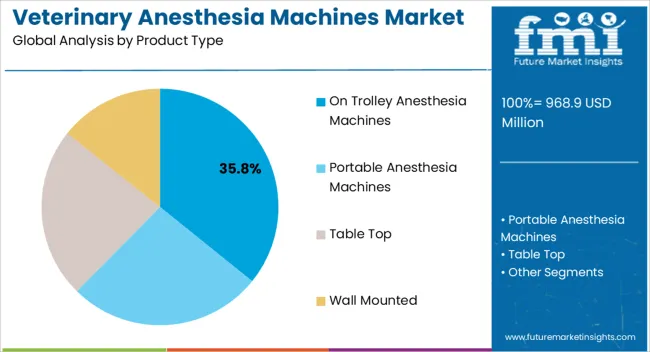
The on trolley anesthesia machines product type segment is projected to hold 35.8% of the market revenue in 2025, establishing it as the leading product type. Growth is being driven by their mobility and versatility, allowing veterinarians to move the equipment easily across surgical theaters or clinical wards. These machines are equipped with precise gas delivery systems, real-time monitoring, and safety alarms, which enhance procedural accuracy and reduce operational risks.
Their compact and ergonomic design facilitates integration in small- and medium-sized clinics where space efficiency is critical. Adoption is further supported by the flexibility to accommodate a wide range of animal sizes and anesthesia protocols.
Manufacturers are focusing on improving machine reliability, ease of maintenance, and software-enabled monitoring capabilities, which enhance clinical confidence and operational efficiency With the growing focus on high-quality veterinary care, on trolley anesthesia machines are expected to maintain their leading position, driven by portability, versatility, and performance optimization across diverse veterinary applications.
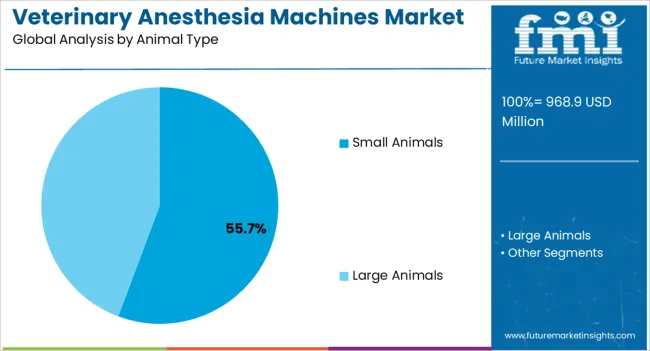
The small animals segment is expected to account for 55.7% of the market revenue in 2025, making it the leading animal type category. Growth is being driven by the increasing prevalence of pet ownership, particularly cats and dogs, which has raised the demand for routine and surgical veterinary procedures. Small animals require specialized anesthesia machines that provide precise dosing, real-time monitoring, and minimal stress during procedures.
Veterinary practices are increasingly adopting machines that can safely accommodate small animal physiology while ensuring high levels of care and safety. Advances in anesthesia technology, including software-assisted monitoring and gas delivery optimization, have further reinforced adoption.
The expansion of veterinary hospitals, specialty clinics, and mobile veterinary services is creating additional demand for small animal anesthesia solutions As awareness of animal health and surgical outcomes continues to rise, the small animals segment is expected to retain its leading share, supported by the need for safe, efficient, and reliable anesthesia solutions tailored to small animal care.
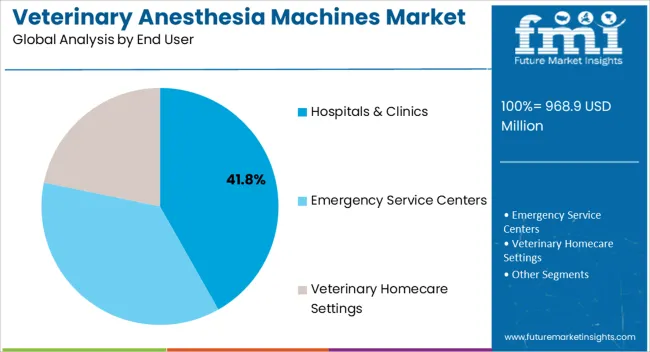
The hospitals and clinics end-user segment is projected to hold 41.8% of the market revenue in 2025, establishing it as the leading end-use category. Growth is driven by the increasing number of veterinary hospitals and specialty clinics offering surgical and critical care services. These facilities require advanced anesthesia machines that can handle diverse animal sizes and provide real-time monitoring for optimized procedural outcomes.
Adoption is further supported by the emphasis on operational efficiency, patient safety, and regulatory compliance within professional veterinary practice. Integration of anesthesia machines with monitoring software, digital recordkeeping, and multi-functional capabilities allows hospitals and clinics to enhance service quality and reduce operational risks.
As veterinary healthcare infrastructure expands and modernizes globally, hospitals and clinics remain the primary driver of market growth The need for reliable, high-performance anesthesia solutions that improve surgical precision and patient outcomes ensures the continued leadership of this end-user segment, supported by investments in advanced veterinary care technologies and professional training.
Anesthesia is a type of medicine which is used to control or reduce the pain during surgical procedures. It also helps in breathing, heart rate, blood flow, and blood pressure. General anesthesia fulfills three main objectives i.e. unconsciousness, lack of movement, and blunting of the stress response. In animals, anesthesia is used for a different circumstance, as animal lacks the ability to cooperate during diagnosis and therapeutic procedures.
Anesthesia medication is majorly used to minimize the surgical stress and pain management. Anesthesia can be delivered through different routes. However, anesthesia via air pressure using anesthesia machines is a safe, secure and widely adopted mode.
The concept of anesthesia machines has been evolved from standalone to portable wireless devices that comprise monitors and information systems. Currently, the manufacturers are introducing anesthesia machines with more advanced features such as new mode of ventilation, clear picture offering loops and graphical screens.
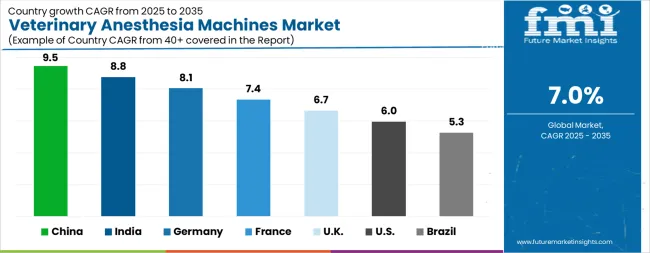
| Country | CAGR |
|---|---|
| China | 9.5% |
| India | 8.8% |
| Germany | 8.1% |
| France | 7.4% |
| UK | 6.7% |
| USA | 6.0% |
| Brazil | 5.3% |
The Veterinary Anesthesia Machines Market is expected to register a CAGR of 7.0% during the forecast period, exhibiting varied country level momentum. China leads with the highest CAGR of 9.5%, followed by India at 8.8%. Developed markets such as Germany, France, and the UK continue to expand steadily, while the USA is likely to grow at consistent rates. Brazil posts the lowest CAGR at 5.3%, yet still underscores a broadly positive trajectory for the global Veterinary Anesthesia Machines Market. In 2024, Germany held a dominant revenue in the Western Europe market and is expected to grow with a CAGR of 8.1%. The USA Veterinary Anesthesia Machines Market is estimated to be valued at USD 335.8 million in 2025 and is anticipated to reach a valuation of USD 598.6 million by 2035. Sales are projected to rise at a CAGR of 6.0% over the forecast period between 2025 and 2035. While Japan and South Korea markets are estimated to be valued at USD 45.3 million and USD 29.1 million respectively in 2025.
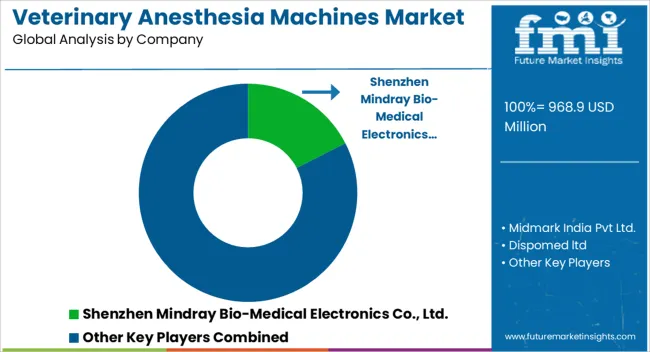
| Item | Value |
|---|---|
| Quantitative Units | USD 968.9 Million |
| Product Type | On Trolley Anesthesia Machines, Portable Anesthesia Machines, Table Top, and Wall Mounted |
| Animal Type | Small Animals and Large Animals |
| End User | Hospitals & Clinics, Emergency Service Centers, and Veterinary Homecare Settings |
| Regions Covered | North America, Europe, Asia-Pacific, Latin America, Middle East & Africa |
| Country Covered | United States, Canada, Germany, France, United Kingdom, China, Japan, India, Brazil, South Africa |
| Key Companies Profiled | Shenzhen Mindray Bio-Medical Electronics Co., Ltd., Midmark India Pvt Ltd., Dispomed ltd, B. Braun SE, Kent Scientific Corporation., ICU Medical, Inc., VETLAND MEDICAL SALES & SERVICES., Supera Anesthesia Innovations., Avante Animal Health, and RWD Life Science Co., LTD |
The global veterinary anesthesia machines market is estimated to be valued at USD 968.9 million in 2025.
The market size for the veterinary anesthesia machines market is projected to reach USD 1,906.0 million by 2035.
The veterinary anesthesia machines market is expected to grow at a 7.0% CAGR between 2025 and 2035.
The key product types in veterinary anesthesia machines market are on trolley anesthesia machines, portable anesthesia machines, table top and wall mounted.
In terms of animal type, small animals segment to command 55.7% share in the veterinary anesthesia machines market in 2025.






Our Research Products

The "Full Research Suite" delivers actionable market intel, deep dives on markets or technologies, so clients act faster, cut risk, and unlock growth.

The Leaderboard benchmarks and ranks top vendors, classifying them as Established Leaders, Leading Challengers, or Disruptors & Challengers.

Locates where complements amplify value and substitutes erode it, forecasting net impact by horizon

We deliver granular, decision-grade intel: market sizing, 5-year forecasts, pricing, adoption, usage, revenue, and operational KPIs—plus competitor tracking, regulation, and value chains—across 60 countries broadly.

Spot the shifts before they hit your P&L. We track inflection points, adoption curves, pricing moves, and ecosystem plays to show where demand is heading, why it is changing, and what to do next across high-growth markets and disruptive tech

Real-time reads of user behavior. We track shifting priorities, perceptions of today’s and next-gen services, and provider experience, then pace how fast tech moves from trial to adoption, blending buyer, consumer, and channel inputs with social signals (#WhySwitch, #UX).

Partner with our analyst team to build a custom report designed around your business priorities. From analysing market trends to assessing competitors or crafting bespoke datasets, we tailor insights to your needs.
Supplier Intelligence
Discovery & Profiling
Capacity & Footprint
Performance & Risk
Compliance & Governance
Commercial Readiness
Who Supplies Whom
Scorecards & Shortlists
Playbooks & Docs
Category Intelligence
Definition & Scope
Demand & Use Cases
Cost Drivers
Market Structure
Supply Chain Map
Trade & Policy
Operating Norms
Deliverables
Buyer Intelligence
Account Basics
Spend & Scope
Procurement Model
Vendor Requirements
Terms & Policies
Entry Strategy
Pain Points & Triggers
Outputs
Pricing Analysis
Benchmarks
Trends
Should-Cost
Indexation
Landed Cost
Commercial Terms
Deliverables
Brand Analysis
Positioning & Value Prop
Share & Presence
Customer Evidence
Go-to-Market
Digital & Reputation
Compliance & Trust
KPIs & Gaps
Outputs
Full Research Suite comprises of:
Market outlook & trends analysis
Interviews & case studies
Strategic recommendations
Vendor profiles & capabilities analysis
5-year forecasts
8 regions and 60+ country-level data splits
Market segment data splits
12 months of continuous data updates
DELIVERED AS:
PDF EXCEL ONLINE
Veterinary Point of Care Diagnostics Market Size and Share Forecast Outlook 2025 to 2035
Veterinary Allergy Diagnostics Market Size and Share Forecast Outlook 2025 to 2035
Veterinary TSE Testing Market Size and Share Forecast Outlook 2025 to 2035
Veterinary Dermatology Market Forecast Outlook 2025 to 2035
Veterinary Telemedicine Market Size and Share Forecast Outlook 2025 to 2035
Veterinary Dietary Supplements Market Size and Share Forecast Outlook 2025 to 2035
Veterinary Imaging Market Forecast and Outlook 2025 to 2035
Veterinary CRISPR-Based Detection Kits Market Size and Share Forecast Outlook 2025 to 2035
Veterinary Pregnancy Test Kit Market Forecast and Outlook 2025 to 2035
Veterinary X-Ray Illuminators Market Size and Share Forecast Outlook 2025 to 2035
Veterinary Scales Market Size and Share Forecast Outlook 2025 to 2035
Veterinary Grooming Aids Market Size and Share Forecast Outlook 2025 to 2035
Veterinary Micro-fibre Endoscope Market Size and Share Forecast Outlook 2025 to 2035
Veterinary Faecal Filters Market Size and Share Forecast Outlook 2025 to 2035
Veterinary Dental Equipment Market Size and Share Forecast Outlook 2025 to 2035
Veterinary Rapid Test Market Size and Share Forecast Outlook 2025 to 2035
Veterinary Therapeutic Diet Market Size and Share Forecast Outlook 2025 to 2035
Veterinary Glucometers Market Size and Share Forecast Outlook 2025 to 2035
Veterinary Pain Management Drugs Market Size and Share Forecast Outlook 2025 to 2035
Veterinary Thermography Market Size and Share Forecast Outlook 2025 to 2035

Thank you!
You will receive an email from our Business Development Manager. Please be sure to check your SPAM/JUNK folder too.
Chat With
MaRIA